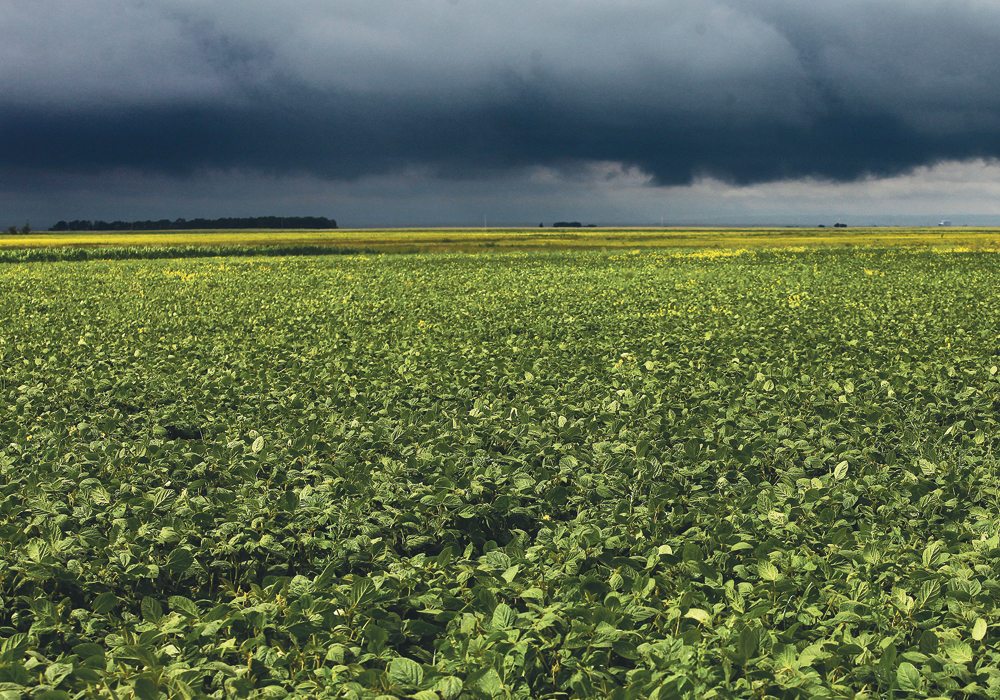Rotating soybeans with canola could be an option financially, but agronomically, is this choice going to work?
BRANDON — Canola and soybeans were the biggest crops in Manitoba last year, representing more than half of all seeded acres in the province.
Given the scale of the two crops, it’s logical that many producers are growing soybeans and canola in rotation.
Agronomists still aren’t sure if that’s a good idea or not because there’s almost no research on the concept.
Holly Derksen, Manitoba Agriculture’s field crop pathologist, searched for studies on canola-soybean rotations and could find only two that apply to the northern Plains: one from the North Dakota and one from Manitoba.
Read Also

Drones now used to assess wildlife crop damage in Saskatchewan
Wildlife damage in Saskatchewan crops is now assessed by drones and artificial intelligence.
“It’s peanuts (for research) at this point in time but it’s what we have to start (with),” said Derksen, who spoke at Brandon’s Manitoba Ag Days in January.
Growing canola after soybeans or soybeans after canola is something that requires more research because soybeans are now a broad acreage crop in Western Canada.
More than three million acres were planted to soybeans in Manitoba and Saskatchewan last year, and advocates of the crop expect that figure to climb higher, perhaps reaching five million.
“There’s a lot of canola in the West, and that’s where soybeans are moving into,” Derksen said.
“It’s not replacing canola in the rotation, it’s being added into the rotation.”
Growing canola and soybeans back to back is worrisome for plant disease experts because the two crops are susceptible to a number of the same diseases.
The list includes sclerotinia and a few root rot pathogens such as pythium, rhizoctonia and fusarium.
Some growers may assume that sclerotinia isn’t related to crop rotation because it’s more connected to a wet growing season, but evidence from 2016 and 2017 suggests there is a carry-over from year to year. The sclerotinia pressure in Manitoba was severe in 2016, and it carried over into 2017, even though it was a dry year.
Derksen said sclerotinia incidence across Manitoba was higher than expected in 2017. Consequently, growers may want to avoid seeding a crop susceptible to sclerotinia following a year with high disease pressure.
“Rotation isn’t on the top of the list on how you manage sclerotinia,” she said. “But I think it does play a role when you have a really bad year (for sclerotinia) and you get a huge amount of inoculum added to the soil.”
Despite having diseases in common, anecdotal evidence from the United States indicates that soybean yields are higher following a crop of canola. As a result, some growers have concluded that the crops work together in synergy.
Scientists at North Dakota State University conducted trials at four locations in North Dakota and Minnesota n 2015 and 2016 to test the synergy concept.
They compared wheat-canola to soybeans-canola and wheat-soybeans to canola-soybeans.
They found no difference in yield, test weight, oil content and other factors at the three North Dakota sites. In other words, growing canola and soybeans in succession had no ill affects but no benefits either.
However, the site in Roseau, Minn., was different.
Soybean yields were higher following canola in one year, and canola yields were slightly higher following soybeans in both years.
Derksen said the NSDU findings are inconclusive, likely because the study lasted for only two years.
“I would say the North Dakota one didn’t give us a lot of straightforward answers.”
The University of Manitoba study was more interesting, Derksen said.
Ahmed Abdelmagid, a post-doctoral researcher with Fouad Daayf in the university’s plant science department, studied four rotations: continuous soybeans, canola-soybean, corn-soybean and wheat-canola-corn-soybean.
The continuous soybean rotation had the worst severity of root rot, but the canola-soybean sequence also amplified root rot.
“They saw significantly higher root rot in soybeans when it was a canola-soybean rotation versus a corn-soybean rotation,” Derksen said.
“It gives us an indication that the canola crop is adding to the inoculum and making that root rot a bit worse in soybeans.”
There may be a disease synergy between canola and soybeans, but that hasn’t shown up in yield results from Manitoba. Data from the Manitoba Agricultural Services Corp. shows that growing soybeans-canola or canola-soybeans doesn’t reduce yields.
That data is reassuring but the same question remains: is a rotation with both canola and soybeans sustainable over 10 or 15 years?
Derksen offered the standard scientific answer: more research is needed.
“I imagine we’ll see some (more research),” she said.
“Where do soybeans fit in the rotation, long term?”
















